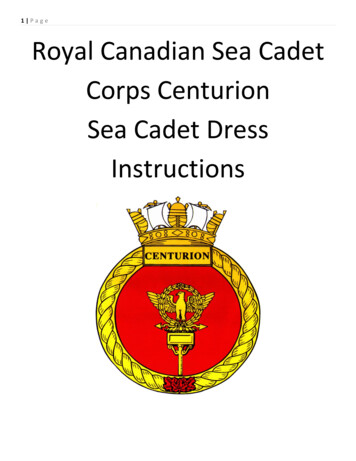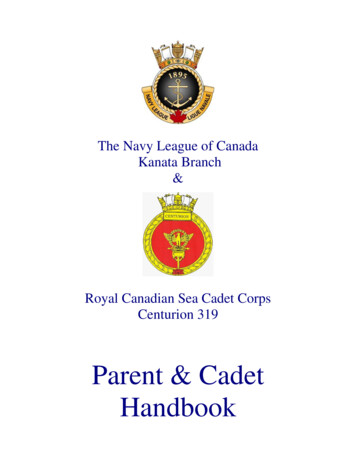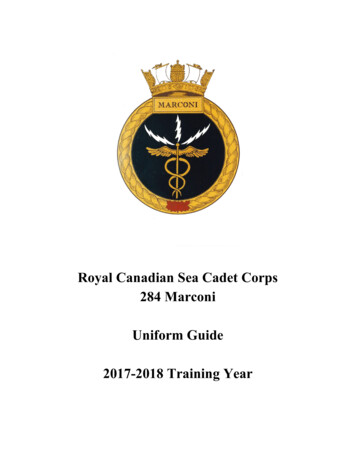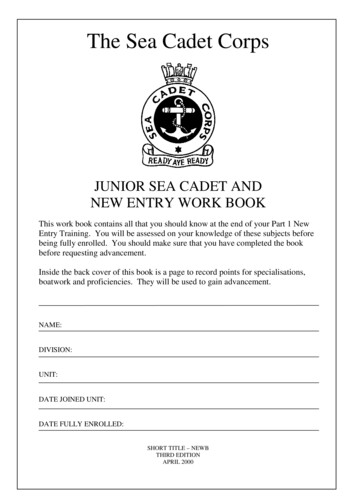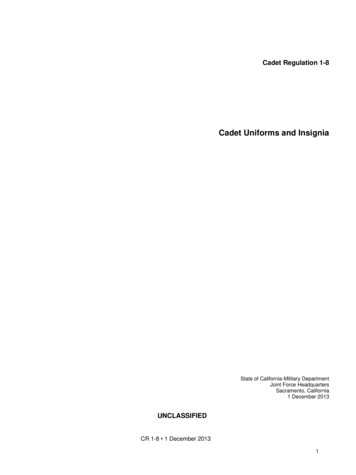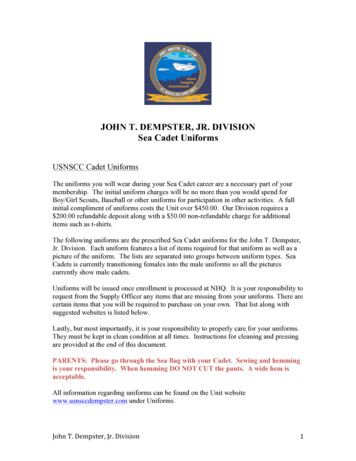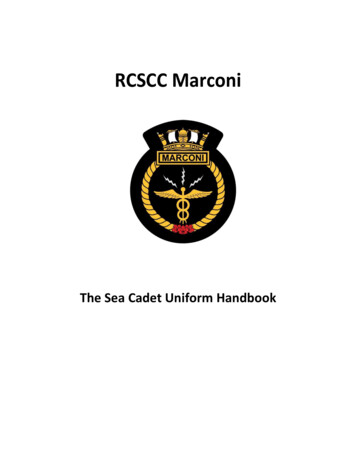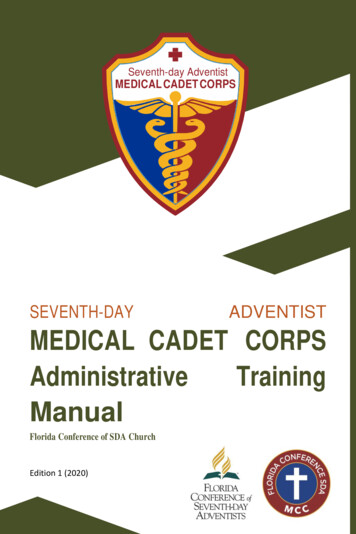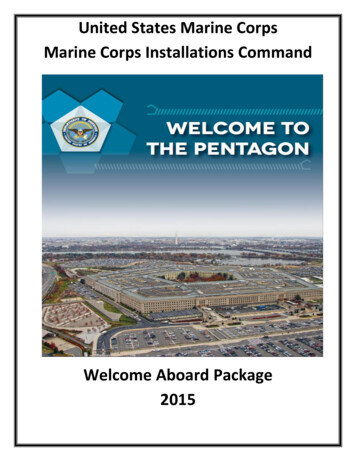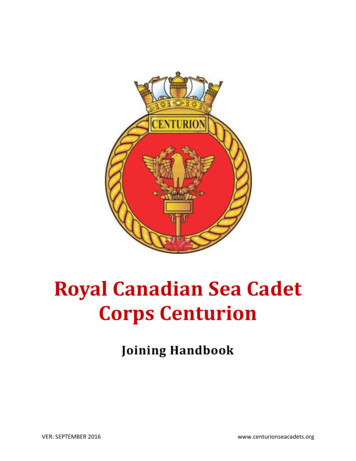
Transcription
Royal Canadian Sea CadetCorps CenturionJoining HandbookVER: SEPTEMBER 2016www.centurionseacadets.org
Table of ContentsWhat is the Sea Cadet Program? . 4Parents’ and/or Guardians’ Page . 5Why choose Sea Cadets? . 5How much does the program cost? . 5The Navy League of Canada . 5Kanata Branch . 5General Overview . 6Training . 6Regular Parade Nights. 6Mandatory and Supplementary Training . 6Expected Behaviour . 6Sea Cadet Corps Structure . 6Officer Staff . 6Divisional System . 7Cadet Appointments/Positions . 7Chain of Command. 8Teams . 8Annual Ceremonial Review . 8Summer Training . 8Uniform . 9Basic Uniform Parts . 9Orders of Dress . 10Ceremonial Dress (C1). 10Service Dress (C3). 10Sea Training Uniform (STU) . 10Personal Appearance . 10Hair and Grooming . 10Jewelry . 10Ranks . 113
What is the Sea Cadet Program?MissionThe mission of the Canadian Cadet Organization (CCO) is to contribute to the development andpreparation of youth for the transition to adulthood, enabling them to meet the challenges of modernsociety, through a dynamic, community-based program.VisionThe vision of the cadet program is to be a relevant, credible and proactive youth developmentorganization, offering the program of choice for Canada’s youth, preparing them to become the leadersof tomorrow through a set of fun, challenging, well-organized and safe activities.AimThe aim of the CCO has three parts:1. develop in youth the attributes of good citizenship and leadership;2. promote physical fitness; and3. stimulate the interest of youth in the sea, land and air activities of the Canadian Forces.MottoThe motto of Sea Cadets in particular is “Ready, Aye, Ready”, following suit from the Royal CanadianNavy. It means we are ready to face whatever challenges the seas may bring.History of RCSCC CenturionIn 1990, Lt(N) Ret. Bill Wilson decided to create a sea cadet corps in Kanata to address the growing needto fill the gap in one of the fastest growing suburbs of the country. A small group of Cadet InstructorCadre officers were recruited, and its charter was granted. Training commenced in September 1992.The corps operated its training out of Katimavik Elementary Public School for the first half of itsinaugural training year, and then moved to A.Y. Jackson Secondary School in January of 1993. During thecorps’ four-year stay there, the ship’s company grew to over sixty cadets and had a full complement ofband, drill and sail training.After a brief stint at Earl of March Secondary School during the 1996-97 training year, the corps movedto Connaught Range and Primary Training Centre, operating out of the offices of the army cadet camp,and utilizing the Range Control building for drill and nearby portables for classroom training. In 1999,RCSCC Centurion moved into its present location in the new Cadet Training Building at 5 BrouilletteBoulevard.During the summer of 2006 the corps acquired its own portable and moved the LHQ (localheadquarters) to its new home. The corps has been sailing for many years and has participated innumerous flotilla competitions, winning several trophies and provincial awards.4
Parents’ and/or Guardians’ PageWhy choose Sea Cadets?The Sea Cadet Program provides many advantages to youths from 12-18 years old. Many skills learned inSea Cadets can be used in everyday life. In particular, we offer a variety of nautical activities that areunique to Sea Cadets such as sailing a variety of seagoing vessels. Although one of the aims of theprogram is to instill an interest in the Canadian Armed Forces (CAF), being in Sea Cadets does NOT makeyour child a part of the military. Cadets make absolutely no commitments regarding military service, andthey are free to leave at any time. That being said, those who decide to join the CAF later on start outwith the advantage of having gained valuable experience through the cadet program.How much does the program cost?It is free! The program itself – including the uniform – does not cost anything. It is funded through apartnership between the Department of National Defence (DND) and the Navy League of Canada.Essentially, DND assumes the cost of mandatory training and uniforms and the Navy League coverssupplemental training. There are few occasions where parents will be required to subsidize costs; everyeffort is made to cover the cost in advance. We do fundraising throughout the year to fund certainactivities that go above regular training.The Navy League of CanadaThe Navy League of Canada was established in 1895 to promote an interest in Maritime Affairs generallythroughout Canada. Today, the Navy League of Canada has a presence in over 260 Canadiancommunities. Our youth programs benefit 15 000 young Canadians every year, and we continue togrow. (Source: www.navyleague.ca).Kanata BranchThe Navy League of Canada, Kanata Branch, is the sponsoring committee for RCSCC Centurion.The Navy League is comprised of volunteers, primarily parents, who in a combined effort with the cadetstaff, raise funds necessary for and plan the events and activities for the cadets. The Navy League meetsduring regular cadet training on the second Tuesday of every month, and welcomes anyone who is ableto volunteer a few hours a month. As part of the Navy League, you can obtain a greater understandingof what the sea cadet corps offers cadets. Having input into the planning, you gain firsthand knowledgeof dates, times and events that are planned for the cadets.If you are interested in joining the Navy League, have questions about the League, or would like to helpout in any way, please contact one of our members and/or visit our page on the website.5
General OverviewTrainingRegular Parade NightsWe parade every Tuesday at 1830hrs (6:30pm). We begin the night with raising the Canadian flag, whichwe call Colours. We then continue with lessons throughout the evening with a 15-minute break inbetween, finishing the night with lowering the Canadian flag, which we call Sunset. The training programis split into five phases that the cadets move through that are designed to align with theirdevelopmental period. As they progress through the program, they are given more responsibility andlearn how to teach their peers.Mandatory and Supplementary TrainingHere are some examples of the various types of training we do:-Sailing, seamanship and nautical trainingCitizenship and community serviceCeremonial drillMilitary bandAir rifle marksmanshipOrienteering and biathlonPersonal Fitness, healthy living and recreational sportsLeadership and instructional techniqueExpected BehaviourThere is a certain level of behaviour that is expected of cadets. All cadets are required to sign a code ofconduct and must participate in our Positive Social Relations for Youth (PSRY) program. Much like atschool, cadets learn about their rights and the rights of others and also develop respect for boththemselves and their fellow cadets and staff. We offer a safe and inclusive environment for all personsfree of harassment regardless of race, religion, gender, sexual orientation or any other reason. Anybreeches of the code of conduct are subject to inquiry and investigation and will be dealt withaccordingly.Sea Cadet Corps StructureOfficer StaffCommanding Officer (CO). The CO is in charge of a unit.Executive Officer (XO). The XO is second-in-command at a sea cadet unit. He/she reports directly to theCO, and all other officers report to him/her.Training Officer (TrgO). The TrgO is in charge of training at the cadet unit. He/she schedules training,assigns instructors, and ensures training objectives are being met.6
Administration Officer (AdminO). The AdminO is in charge of the administrative side of things. He/she isresponsible for things such as registering new cadets, keeping attendance and tracking mail.Supply Officer (SupO). The SupO is in charge of issuing uniform parts to cadets and maintaining theunit’s supplies.These are the general positions within a unit; however, the corps may employ several other adult staffmembers to fulfill additional roles such as instructors, specialty instructors and volunteers. Thecomplement of adult staff is often a mix of Cadet Instructor Cadre (CIC) officers, Regular Force orReserve Force volunteers and civilian volunteers. All adult staff are required to undergo VulnerabilitySector Screening and will also participate in the Positive Social Relations for Youth (PSRY) program.Divisional SystemOn Tuesday nights, cadets are split into groups called divisions. We currently have three divisions:Griffon, Magnificent and Drake. Griffon is the primary cadet division which all cadets start in when theyfirst enroll. Magnificent is the guard that carries drill purpose rifles and performs ceremonial rifle drillduring all parades. Drake is the band division that provides musical support at all parades andceremonial events. Each division has a Divisional Officer or DivO (adult staff) and a Divisional PettyOfficer or DPO (senior cadet) who ensure that the cadets within their group are well cared for and thattheir needs met.Cadet Appointments/PositionsCoxswain (Coxn). He/she is the head cadet and is responsible for ensuring the proper conduct of allcadets, making sure duties are followed and assisting the officers as required.Regulating Petty Officer (RPO). He/she is responsible for ensuring the good discipline of all cadetswithin the corps. In addition, the RPO acts as the second-in-command in the absence of the Coxn.Corporal of the Gangway. The Corporal of the Gangway controls the ceremonial aspects of parades.They oversee the raising and lowering of the Canadian flag. They also alert the parade of the arrival ofthe Reviewing Party.Ship’s Writer. He/she assists with the administration of the corps. They can ensure that attendance iscorrectly taken during training activities. They also may help out within the supply section of the corps,ensuring cadets have the uniform parts they need. They may be responsible for calling cadets who aremissing during training.Divisional Petty Officer (DPO). The DPO is the first point of contact for all cadets and the lowest level ofthe chain of command. The DPO is responsible for regular and ongoing communication with cadets, formaking sure that all the cadets in their division have all the relevant information for any
The motto of Sea Cadets in particular is “Ready, Aye, Ready”, following suit from the Royal Canadian Navy. It means we are ready to face whatever challenges the seas may bring. History of RCSCC Centurion In 1990, Lt(N) Ret. Bill Wilson decided to create a sea cadet corps in Kanata to address the growing need
